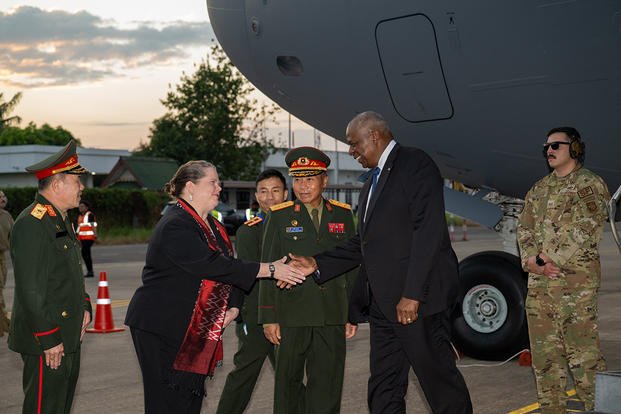Jobs
‘We Need You’: Defense Secretary Stands Up for Women in Combat Jobs amid Hegseth Nomination

Defense Secretary Lloyd Austin on Wednesday defended women serving in the military and, specifically in combat roles, amid growing scrutiny of comments by his would-be successor, Pete Hegseth.
“I see that because of my experience, and that experience is extensive … I think our women add significant value to the United States military, and we should never change that,” Austin told reporters Wednesday while traveling in Laos.
The remarks come after President-elect Donald Trump nominated now-former Fox News host Hegseth for the top Pentagon position. In his writing and media appearances, Hegseth has made clear that he opposes female troops serving in combat positions.
Read Next: Coast Guard Set to Receive New Icebreaker by Year’s End, Bolstering US Presence in Arctic
In an appearance on “The Shawn Ryan Show” earlier this month, Hegseth said that allowing women to serve in combat “hasn’t made us more effective, hasn’t made us more lethal, has made fighting more complicated” and that he was “straight-up saying we should not have women in combat roles.”
Hegseth, who also had a fairly typical military career that spanned 13 years as a part-timer in the National Guard and culminated in the midlevel rank of major, dedicated a significant portion of his latest book to criticizing the inclusion of women in combat roles.
In the book, Hegseth strongly insinuated, without much evidence, that women benefit from preferential treatment and rise through the ranks at the expense of more qualified men.
Hegseth claimed that Adm. Lisa Franchetti, the top Navy officer and the first woman to hold the post, was unqualified for the job and was chosen for the role, because “politics is all about optics instead of results.”
Over her decades-long career, Franchetti served on a handful of ships, including commanding the destroyer USS Ross before being selected to lead a destroyer squadron. As an admiral, she commanded the U.S. forces in South Korea, two carrier strike groups and U.S. Naval Forces Europe before being selected as the Navy’s No. 2 officer — vice chief of naval operations.
“Naval operations being weakened won’t matter to anyone,” Hegseth added.
Meanwhile, Austin said that in his “three long tours to Iraq and then one to Afghanistan, every place I went, there were women doing incredible things, and they were adding value to the overall effort, whether they were pilots, whether they were operational experts, whether they were intel experts.”
However, the defense secretary stressed that he doesn’t know Hegseth personally “so I can’t comment on and won’t comment on anything that he said.”
Austin’s decades-long military career, which began in 1975, saw him rise through the ranks and command troops at a variety of levels in the Middle East throughout the Global War on Terrorism.
He would not only go on to be the first African American to command an infantry division in combat but also served as the Army‘s second-highest officer. In 2013, he was tapped to head the U.S. Central Command, where he would command all U.S. military operations in the Middle East during the rise of ISIS in Iraq and Syria.
Austin leaned on that experience in defending the role women play in military combat operations.
“When I was a one-star, I was a deputy commander of the Third Infantry Division,” Austin told reporters, speaking about the Gulf War. The unit “was the major element that conducted the attack … from Kuwait all the way up to Baghdad.”
“My goal was to be in a position where I could see and feel the fight and so that meant that I had to be right there … right behind the lead elements,” he said. “In my command post were several very courageous and very proficient women who did amazing things to support our effort and support their colleagues.”
While the amount of women serving in combat roles is small compared to their male counterparts, they nevertheless make up a significant — and growing — part of the military force.
Military.com has found that the Army has around 3,800 women currently serving in frontline combat roles across the infantry, cavalry, armor and field artillery, while the Marine Corps has nearly 700 women serving in similar roles, including 112 female infantry riflemen and 15 Marine officers.
Data provided by the Marine Corps also showed that since 2018, the number of Marine women in combat roles has increased sixfold for officers and more than tripled for enlisted.
Meanwhile, the Navy, which is different from the two land warfare branches in its structure and operations, considers its submarine service — which is all volunteer and, until 2010, all male — to be a combat role.
The sea service recently said 730 women are currently serving in the submarine force, and it plans to expand the number of subs with women aboard from the current 54 boats up to 61 by 2033.
New submarines, like the recently commissioned USS New Jersey, are also being built with integration in mind.
When Austin was asked whether he had a message to the women currently serving in the military, his answer was direct.
“We need you, we have faith in you, we are appreciative of your service, and you add value to the finest and most lethal fighting force on Earth,” he said.
Related: Thousands of Women Serve in Combat Roles. Pentagon Nominee Hegseth Says They Shouldn’t.








